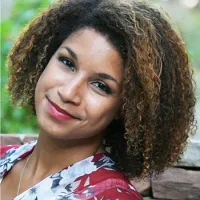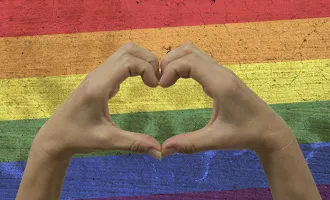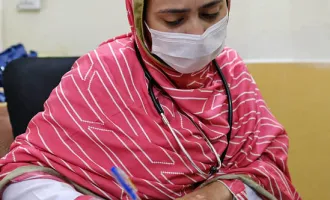
Diversity Shout Out
The voices of UCSF stretch across all backgrounds and walks of life, and they are calling out to be heard. Rich diversity does exist on this campus – students of all shades, students of all sexual orientation and identity, students with disabilities, students from low income households and from other countries — we are diverse, but we are not yet truly inclusive.
Stories of students feeling othered echoed throughout Cole Hall during the second annual student-run forum on diversity and inclusion on Thursday, Jan. 31. Short audio clips presented anecdotal evidence of the rich array of individuals on this campus, and how a lack of inclusion and support is hindering their success.
One student described the simple act of showing up to work every day as a form of activism. It’s difficult to thrive in an environment where you don’t feel accepted, said the student, and simultaneously to carry the weight of constantly explaining yourself and why your perspective matters.
The audio clips were followed by short presentations by representatives of each school on their ongoing efforts to improve inclusivity of diverse groups and their current unmet needs. The forum then transition into a Q&A session with the audience.
Spear-headed by Biomedical Sciences (BMS) graduate student, Aaron Mattingly, this school-wide initiative aims to foster collaboration between the many UCSF student-run organizations working on issues of diversity and inclusion.
Hosting an annual public forum engages the broader UCSF community, with the hope of inspiring allyship from those who don’t face or recognize these challenges. Last year’s forum focused heavily on opening lines of communication among schools. It was the first time an effort had been made to coalesce these issues school-wide in an attempt to support and maintain a population of mixed backgrounds at every university level — student, faculty and staff.
This year, the turn out was incredible. The auditorium was almost completely full with students and faculty from each school.
But what does it mean to be an inclusive campus? Inclusivity means that all members of our community feel accepted and supported. Inclusivity means breaking barriers of micro-aggression, biased educational content, and assumptions that harm the mental wellbeing and academic success of our students.
Having greater diversity contributing to complex problem-solving naturally fosters more scientific creativity. It is also critical to train future physicians in an environment that prepares them to serve a diverse patient population.
What are the barriers to a truly inclusive UCSF?
Marisa Serra, a first year physical therapy student, argued for a broader definition of diversity on campus. Currently, diversity measurements at the administration level are limited to gender, socioeconomic status, and a few ethnic groups (Caucasian, African-American, Latino, other…). We first need to appreciate who exists on this campus to identify ways of engendering inclusivity.
For example, few non-Christian holidays are recognized at the university level. Sina Nazeri, A second year dentistry student, discussed campus efforts to allow recognition of other religious holidays on a by-request basis.
Several schools conveyed the need for more faculty buy-in to student-led initiatives in inclusivity. Faculty and university members in positions of power need to invest both money and time into formal diversity and inclusion training.
Formal training is a very achievable goal. The biomedical sciences graduate program just launched a mandatory training program in mentoring across backgrounds for all faculty that take on new students.
These successes are to be celebrated, but they are fragmented across the schools. Panelists said it was difficult to convince people to commit time and effort into things that don’t affect them personally.
Panelists and audience members examined how institutionalized mentalities impede inclusivity on campus.
One faculty member said that implementing cultural shifts is challenging for older generations like her own. The majority of the time it’s not that older faculty don’t want to be inclusive, she said, but they have to first un-learn old mannerisms and re-learn those that align with modern thinking.
She asked that students extend compassion to those who make mistakes during this transition, and to simply correct them.
Panelist Ben Mansky, a fourth year neuroscience graduate student, said student-led initiatives are meant to generate an environment where students feel comfortable speaking up, not to criminalize a professor who makes a mistake.
The exchange highlighted a key challenge towards a more inclusive and diverse campus — just having conversations about lack of inclusivity and the struggle of underrepresented backgrounds can be uncomfortable. But we need to have them. Karen Lopez-Acero, a nursing student panelist, expressed passionately that only through open, uncomfortable discussions can we begin to understand where the barriers to change truly exist, and how to collaborate among each other to knock them down. The audience reacted with enthusiasm, erupting in applause.
Whose responsibility is it to follow through with these diversity initiatives?
Most often, the underrepresented groups bare the burden of explaining themselves, advocating for their unique identities, and fighting for their acceptance and success here on campus.
The student panelists agreed that it is everyone’s responsibility to improve our campus culture, especially those in positions of privilege or holders or power. Anyone can be an ally and speak out when they witness a member or group in this community being othered. The administration needs to provide space for diverse voices to be heard, and follow through by allocating resources into innovative solutions.
Finally, as people stood to file out of the room, Mattingly called out to the crowd: “Don’t just leave this forum and pat yourself on the back. Have these discussions with peers, staff, faculty. You’re welcome to a seat at the table.”
If you’re interested in becoming directly involved in these discussions, please reach out to myself or one of your diversity RCO leaders.



